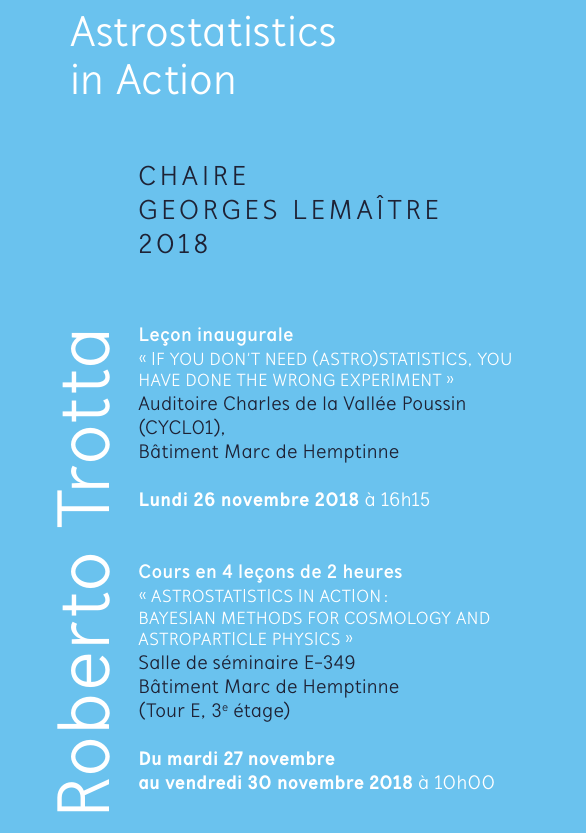The “Chaire Georges Lemaître 2018” is taking place at IRMP the week of the 26th of November. Prof. Roberto Trotta will be giving a serie of lectures from Monday to Friday on “Astrostatistics in Action”.

The program consists in an Inaugural Lecture followed by a reception (Registration here), Monday at 16:15, CYCL01.
If You Don’t need (Astro)Statistics, You Have Done the Wrong Experiment
At the beginning of last century, the physicist and Nobel Prize Winner Ernest Rutherford reportedly believed that “If your experiment needs statistics, you ought to have done a better experiment”. If he were alive today, he probably would not recognize the way cosmology (the study of the Universe on its largest scale) has developed: essentially all of the exciting discoveries in the last two decades have relied on sophisticated statistical analyses of very large and complex datasets. Today, advanced astrostatistical methods belong to the toolbox of almost every cosmologist. In this talk I will give an overview of how cosmologists have established a “cosmological concordance model” that explains extraordinarily well very accurate observations ranging from the relic radiation from the Big Bang to the distribution of galaxies in the sky in the modern Universe. The emerging picture of a cosmos remains puzzling: 95% of the Universe is constituted of unknown components, dark matter and dark energy. Our understanding of the Universe is – already today – limited by our statistical and computational methods. I will discuss how astrostatistics will meet the challenges posed by upcoming extremely large data sets and thereby be instrumental in answering some of the most fundamental questions about the physical reality of the cosmos.
The 2 hours lectures start on Tuesday 10:00 am, room E-349, till Friday. If you intend to follow one, or more, lectures, you MUST register below.
Lecture 1: How to Learn from Experience: Principle of Bayesian Inference
The problem of inference from noisy and/or partial data is ubiquitous in science. It is particularly acute in observational disciplines, like astrophysics and cosmology, where we don’t have the luxury of being able to control our experiments. I will introduce the fundamental principles of Bayesian inference as a complete theory for how to learn from experience, and contrast this approach with the more traditional frequentist view of probability. I will also discuss practical Bayesian methods and technology to determine posterior distributions, including Markov Chain Monte Carlo and related sampling schemes.
Lecture 2: Shaving Theories with Occam’s Razor: Bayesian Model Comparison
Many of the questions in astroparticle physics, cosmology and particle physics aim at establishing which theoretical model is the best explanation for the available data. Classically, theories can only be falsified by ruling them out (the Popperian view). I will demonstrate how the Bayesian model comparison approach is more general, enabling physicists to correctly reward models that make precise predictions that are then verified by experiment or observation. I will contrast this with the hypothesis testing paradigm, and discuss consequences for our understanding of what a “significant result” means. I will illustrate analytical and numerical methods for the implementation of Bayesian model comparison with examples from cosmology and particle physics.
Lecture 3: Bayesian Hierarchical Models and Applications to Supernova Type Ia Cosmology
Thanks to large and accurate measurements obtained in the last 2 decades, and to sophisticated statistical analyses, cosmologists have established a “cosmological concordance model” that reproduces well observations ranging from the relic radiation from the Big Bang to the distribution of galaxies in the sky in the modern Universe. I will review the observational and theoretical underpinnings of this so-called “Lambda-CDM” concordance model of cosmology, which strongly points to the existence of both dark matter and dark energy. I will then focus on recent advances in supernova type Ia cosmology. Supernovae type Ia are a type of stellar explosion that can be used as standard candles to measure extragalactic distances, and have been instrumental in determining the accelerated expansion of the Universe – a smoking gun observation for the existence of dark energy. I will present recent results and a novel, powerful (Bayesian) statistical framework for interpreting the data, including cosmological parameter inference, selection effects and classification in the absence of spectroscopic data. I will discuss upcoming challenges for the field as the quantity and quality of upcoming data sets increases.
Lecture 4: Applications of Astrostatistics to Dark Matter Phenomenology and Beyond the Standard Model Theories
The study of dark matter phenomenology and of underlying theoretical models has advanced dramatically in recent years thanks to the development of “global fits” an approach to combine all available data in a statistically convergent fit of Beyond the Standard Model theoretical parameters. This approach now includes sophisticated methods to simultaneously use direct detection, indirect detection and collider data to constrain the parameter space for dark matter, and map this onto the underlying theory parameters, e.g. in Supersymmetry. I will describe the “global fits” approach and its ability to deliver quantitative inference both from a Bayesian and a frequentist (profile likelihood) point of view. I will review current results in the field and associated challenges.